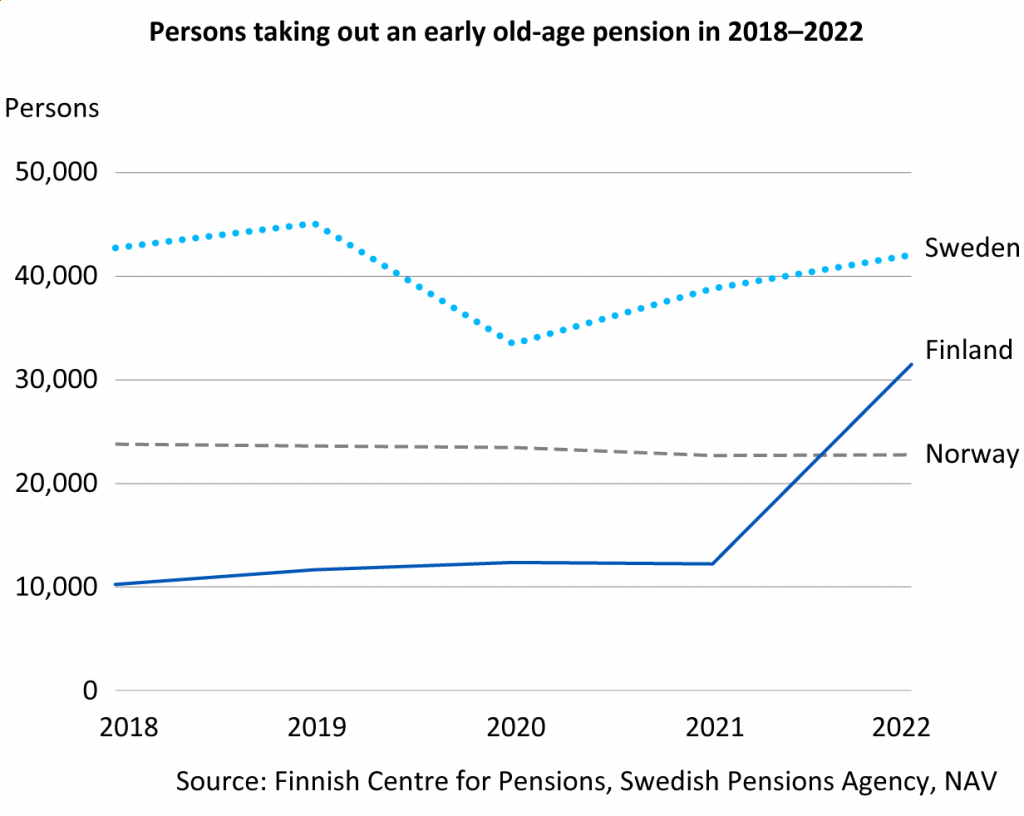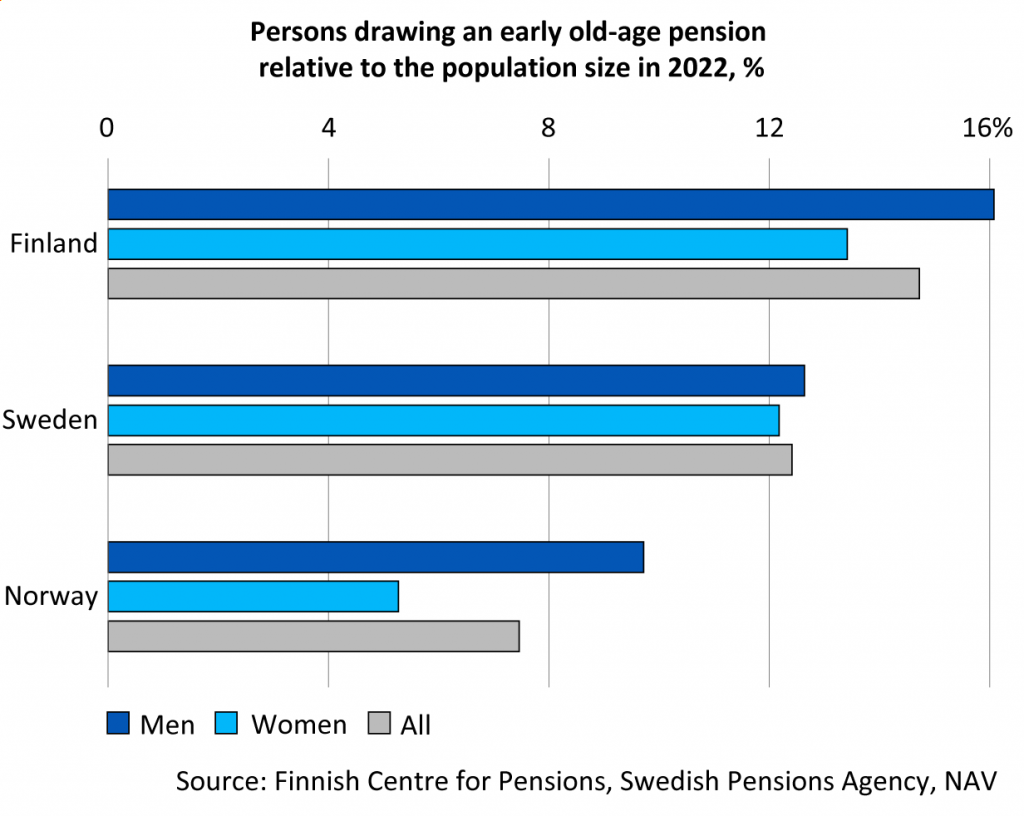Partial old-age pension gaining ground in Finland – more early old-age pension recipients in Finland than in Norway or Sweden
The partial old-age pension has proved to be a popular pension benefit in Finland. Its popularity grew particular in 2022 and seems to continue. In relation to the population, there are more people on a partial old-age pension in Finland than in Sweden or Norway.
The partial old-age pension provides flexibility for those approaching their retirement age and allows people to draw a part of their pension already while working. In Finland, it’s possible to take out 25 or 50 per cent of the pension accrued up to date as of age 61.
A similar pension benefit has been available in Norway as of 2011 and in Sweden as of the turn of the century. Compared to the Finnish model, Sweden and Norway offer more options in terms of how much pension a person can take out early. One option is to take out the entire accrued pension early. This is a clearly more popular alternative than taking out only part of the accrued pension.
Popularity of the partial old-age pension in Finland skyrocketed
As many as every fifth person who was eligible for the partial old-age pension took out the benefit in 2022. Previously, only every tenth person did that. Men are more keen to take out the partial old-age pension than women. The pension’s popularity has increased clearly also among the older age groups.
One of the underlying reasons for the sudden increase in popularity of the partial old-age pension in 2022 was the exceptionally high index increase of earnings-related pensions. This resulted in a higher increase in the pension for those who took out their partial old-age pension in 2022 compared to those who started their pension in 2023. The number of persons who took out the partial old-age pension early nearly tripled in 2022 compared to in 2021 and exceeded the figure in Norway, a country with a population of the same size as that in Finland.
Early retirement declining in popularity in Norway
In 2011, the retirement age in Norway was lowered from 67 to 62 years. This encouraged particularly men to take out their accrued old-age pension. A record-high 36,000 Norwegians took out their old-age pension early in 2011. More than 80 per cent of them were men.
The exploding popularity was partly explained by the fact that five cohorts were allowed to take out the old-age pension early in the same year. After this, the number of new recipients has gone down. In 2022, slightly less than 23,000 Norwegians took out this early retirement benefit.

Early pensions moderately popular in Sweden
At no point have Swedes rushed to early retirement the way Finns and Norwegians have. The gender gap in Sweden is also narrow. Raising the eligibility age for the early old-age pension in Sweden from 61 to 62 years in 2020 was reflected in a declining number of people taking out the early old-age pension that year.
There is no upper age limit for retirement in the Swedish earnings-related pension system. That said, Swedes largely consider the retirement age for the old-age pension to be the age limit set for granting the guaranteed pension, which also functions as the age limit for sickness and unemployment benefits. In this comparison, any pension drawn before the age of 65 years is considered an early pension.

Numerically, Sweden has the largest number of people taking out an early pension. Yet, Sweden’s population is nearly twice as large as Finland’s or Norway’s. When comparing relative to the age groups who are entitled to take out the pension early, the number of persons taking out an early pension was the highest in Finland in 2022.
Nearly every second Norwegian man takes out an early pension
The large share of Norwegians stands out when comparing the recipients of the early old-age pension. Relative to the population, around 40 per cent of the 62–66-year-old Norwegian men receive the benefit. The equivalent figure for women is less than 20 per cent. In the neighbouring countries, the gender gap is not as large although more men than women receive an early old-age pension. In Finland, every fifth male receives the partial old-age pension, and in Sweden, every fourth.
The gender gap in Norway can be explained by, among other things, that more women than men are receiving a disability pension or a supplementary pension from the public sector. In addition, a smaller share of women compared to men meet the criteria of the size of the accrued pension set for early retirement.
Early old-age pension taken out alongside working
Although the main rule is that people take out the early old-age pension as soon as it’s possible, it doesn’t mean that people have stopped working. Often the pension is taken out while working, which tends to be the aim of partial pensions. Unemployed Swedes don’t have the financial incentives to take out an early pension as their counterparts in Finland and Norway have.
The benefit is believed to extend working lives as the elderly can ease their workload towards the end of their career. Sweden has a long history of part-time working. In Norway, 60 per cent of 62–66-year-olds combine work and early retirement. Also in Finland, the majority continues to work. However, at least in Finland and Norway, the trend seems to be to continue working without reducing one’s working hours. The pension is used mainly as an additional income alongside paid employment.
Taxation also affects the popularity of the part-time pension. In Finland, the combination of wage and pension is nearly always more lightly taxed than purely wages or pensions at the same income level. In Sweden, more consideration is required before taking out a pension because its taxation is based not only on the amount of the pension but also on age: the taxation for persons aged 66 or over is lighter than for younger persons due to an additional tax deduction for older people.
Raising the retirement age for the old-age pension in Finland and Sweden pushes people to extend their working lives. It can be assumed to affect the popularity of the early old-age pension, as well. In the end, however, many even surprising personal and social factors underly individual selections. In Finland, the index increase generated the popularity of the partial old-age pension. In Sweden, pensioner reductions in public transport and other services have raised the popularity of the rarer part-time pension in the Stockholm region compared to other regions in Sweden.
Early old-age pension in Finland, Sweden and Norway
| Year 2022 | Eligibility age for the early old-age pension | Retirement age, years | Share of accrued pension, % |
|---|---|---|---|
| Finland1 | 61 | Earnings-related pension 64–69 Guarantee pension: 65 | 25%, 50% |
| Sweden2 | 62 | Earnings-related pension 62– (no upper limit) Guaranteed pension: 65 | 25%, 50%, 75%, 100% |
| Norway | 62 | Earnings-related pension: 62–75 Guarantee pension: 67 | 20%, 40%, 50%, 60%, 80%, 100% |
2 Earnings-related retirement age 63 years and retirement age of the guaranteed pension 66 years in 2023
